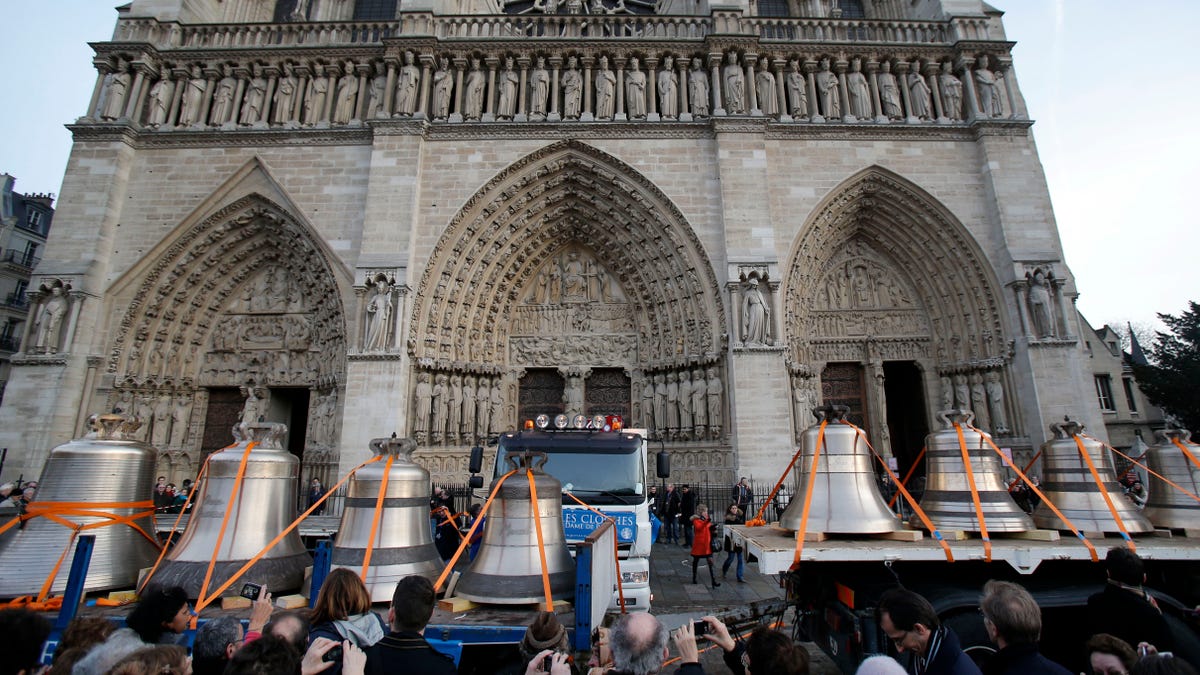
Jan. 31, 2013: Visitors gather around new bells in front of the Notre Dame cathedral, in Paris. (AP)
VILLEDIEU-LES-POELES, France – Nine enormous bronze bells have made their way on flatbed trucks from a Normandy foundry to what is hoped will be their home for centuries to come, Notre Dame Cathedral, helping the medieval edifice to rediscover its historical harmony.
The bells, named after saints and prominent Catholic figures, will be on display at the Paris cathedral from Saturday through Feb. 25. Then, they will be hoisted to its iconic twin towers, where they will replace older bells that became discordant.
The new bells are scheduled to ring for the first time March 23, in time for Palm Sunday and Easter week.
Eight of the nine new bells were cast in a foundry in the Normandy town of Villedieu-les-Poeles. The ninth -- a "bourdon," or Great Bell, named Marie -- was cast in the Netherlands and then sent to Normandy to join the others.
The president of the foundry rang the bells, to the cheers of onlookers, before the nine new bells were sent on a convoy of trucks Thursday from Villedieu-les-Poeles to Paris.
They are joining the cathedral's oldest surviving bell, a Great Bell named Emmanuel, to restore the 10-bell harmony originally conceived for Notre Dame's bell towers.
The old bells, which dated from different periods throughout Notre Dame's history, were out of tune with each other and with Emmanuel, which has hung in the cathedral since the 17th century, according to cathedral officials.
So the diocese decided to have new ones cast as part of celebrations marking 850 years since the beginning of the cathedral's construction in 1163. It took nearly 90 years to build.
The arrival of the bells "is historic precisely because since the 18th century, we haven't experienced such an event," the cathedral's rector, Patrick Jacquin, told Associated Press Television News.
"During the French Revolution, they (the bells) were all brought down and broken except the great bell, Emmanuel, which is here and four other bells that were recast in the middle of the 19th century .... This will complete in a definitive manner the entire set of 10 bells as conceived ... in the Middle Ages."
The euro2 million ($2.7 million) bell-casting project was funded by donations, cathedral officials say.
"Historically the idea of this project was to recreate the old bells of Notre Dame in terms of power, in terms of tune, which means that there will be again 10 bells ringing into the cathedral as it used to be in the Middle Ages and up until the French Revolution," said Paul Bergamo, president of the Cornille-Havard Foundry in Villedieu-les-Poeles.
One of the new bells was named Jean-Marie, after Cardinal Jean-Marie Lustiger, a Jewish-born convert to Catholicism whose mother was killed at the Auschwitz death camp and who later worked to reconcile Catholics and Jews. Lustiger was archbishop of Paris from 1981 to 2005; Jean-Marie was the name he adopted when he converted to Catholicism.
"This is a wonderful return to history and at the same time an extraordinary leap forward because it means that with these bells we are going to endure for the centuries to come," the rector said.




















